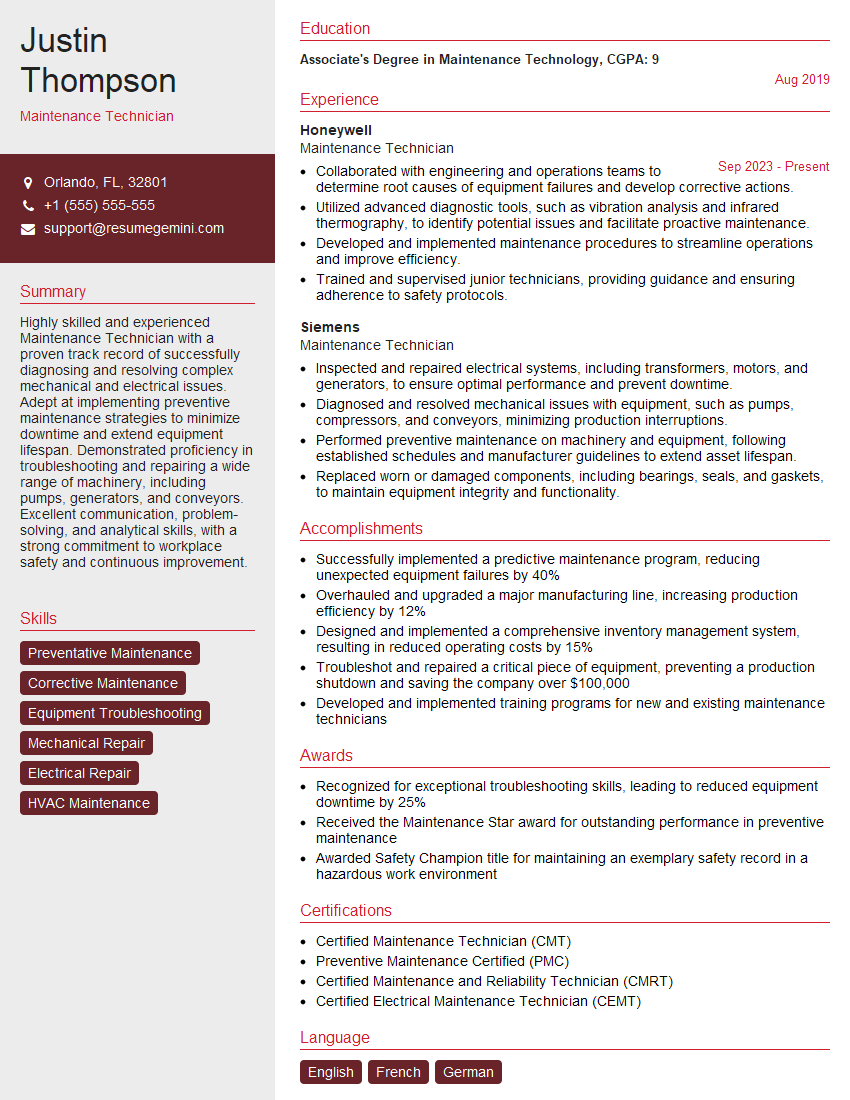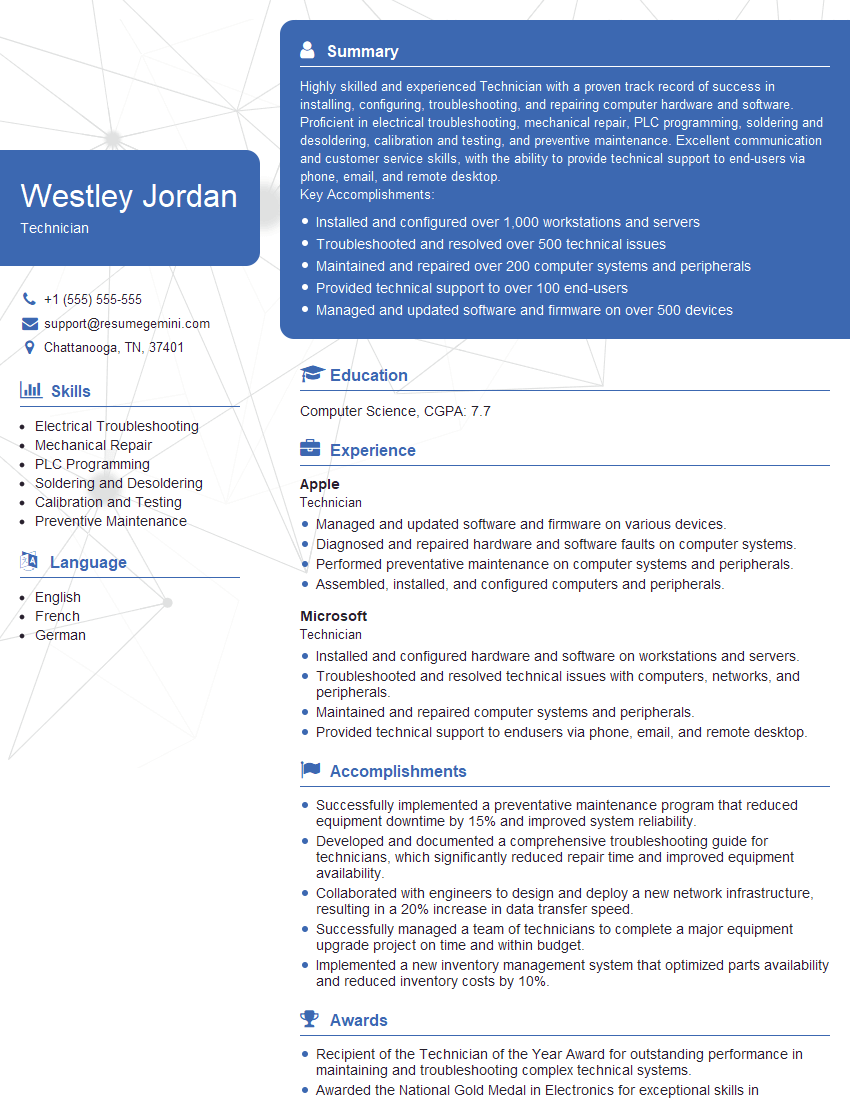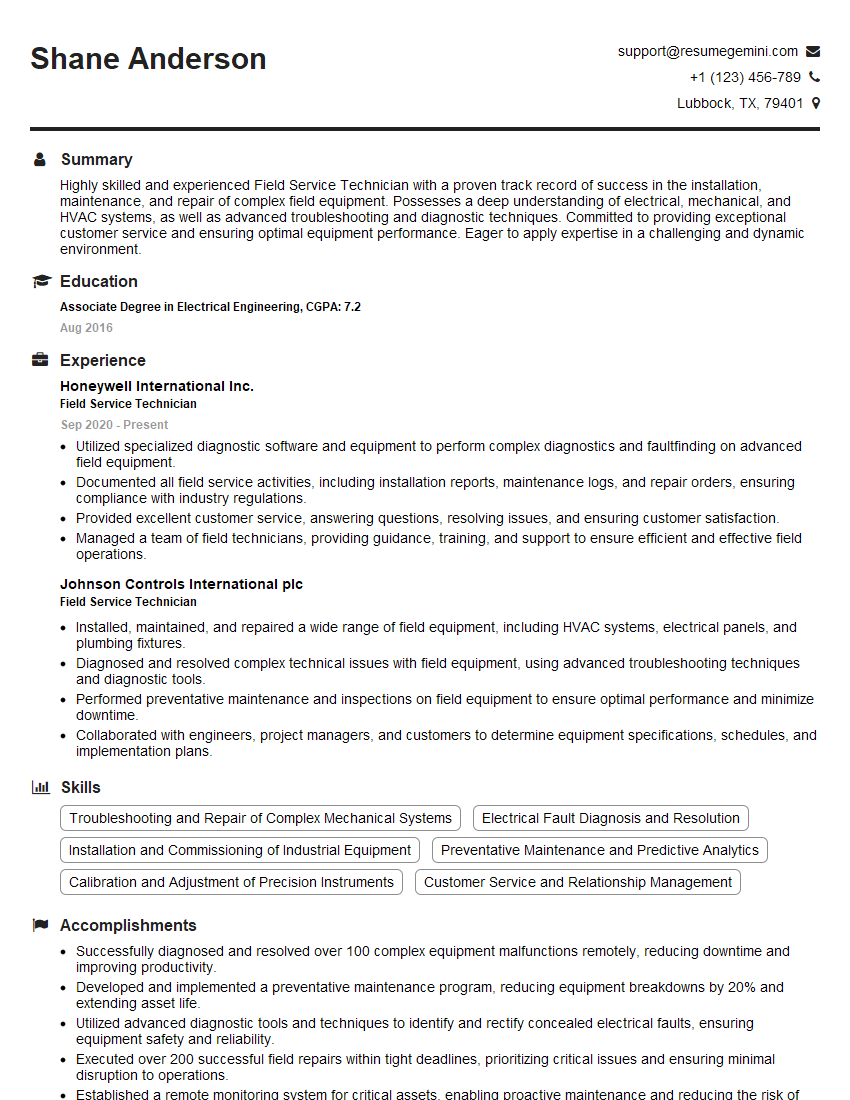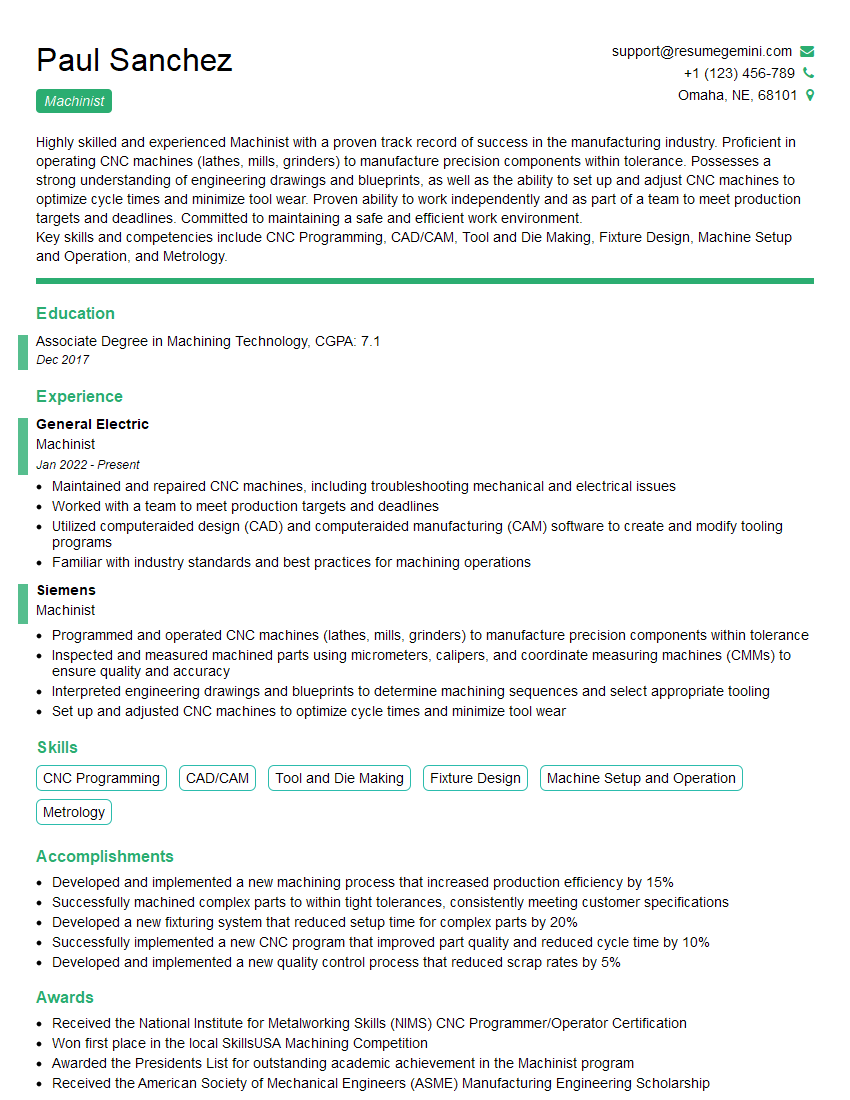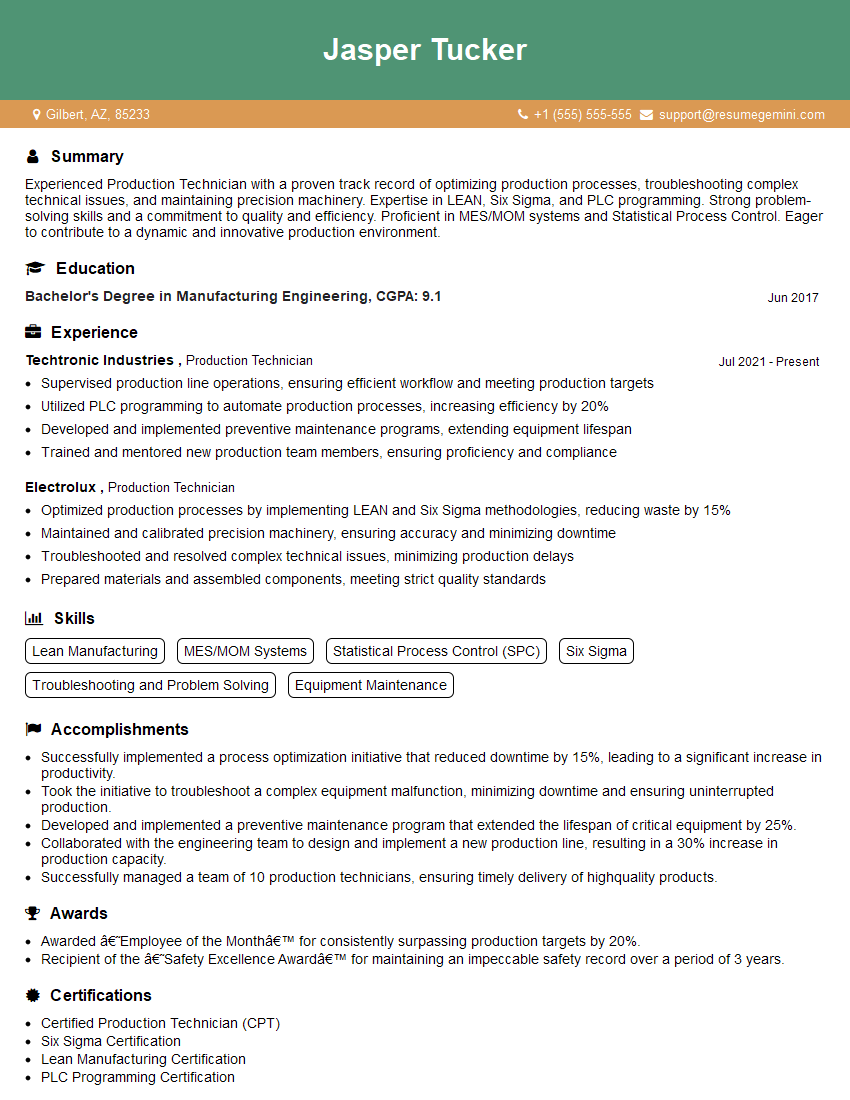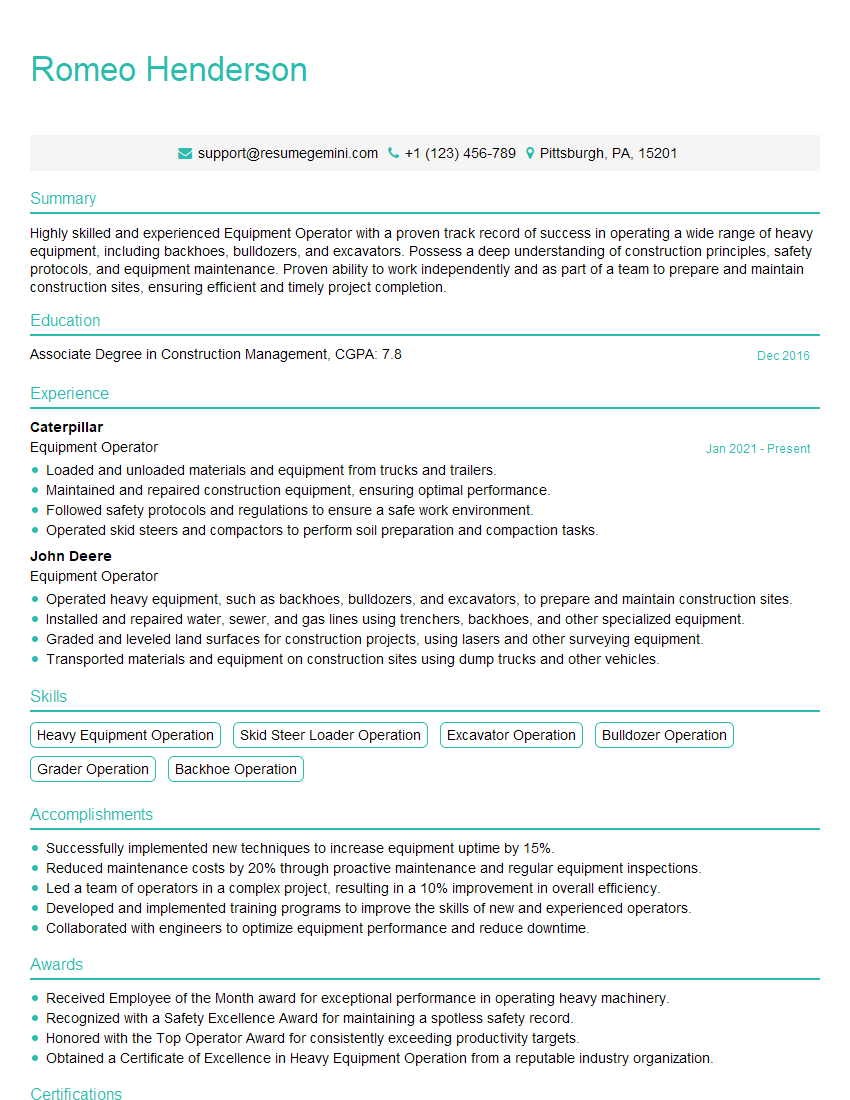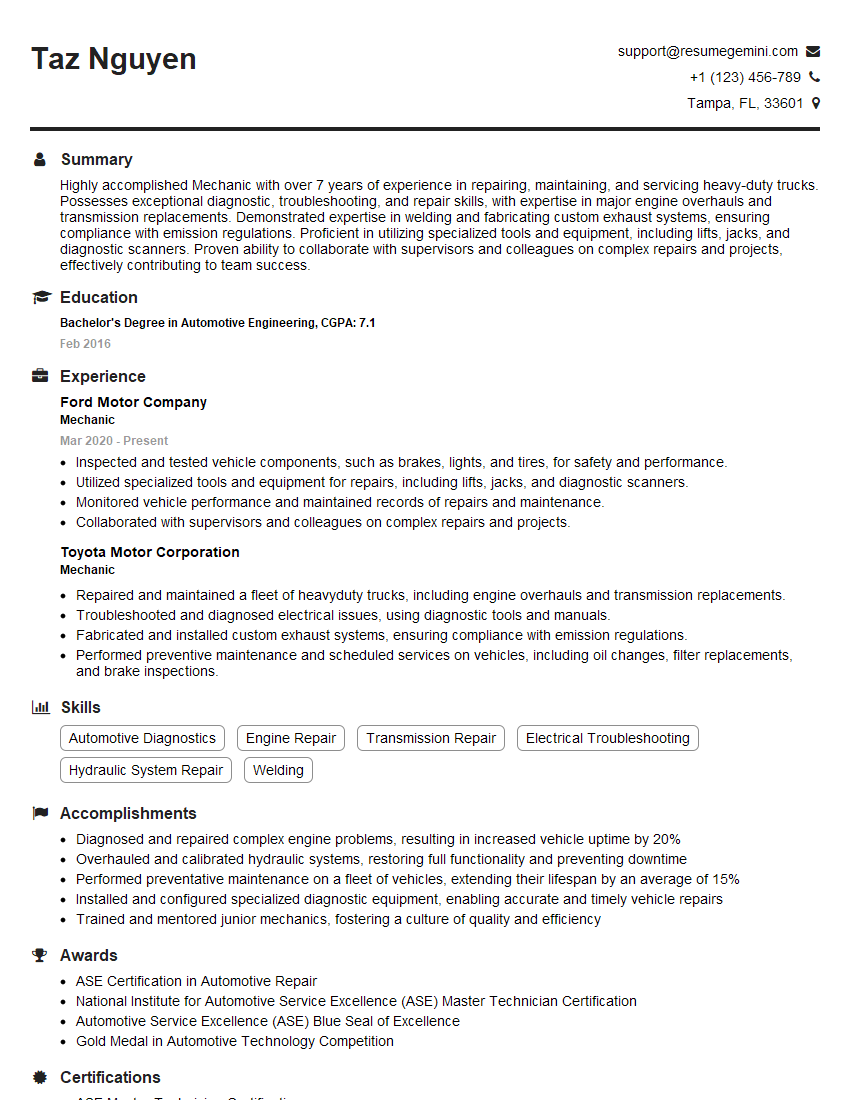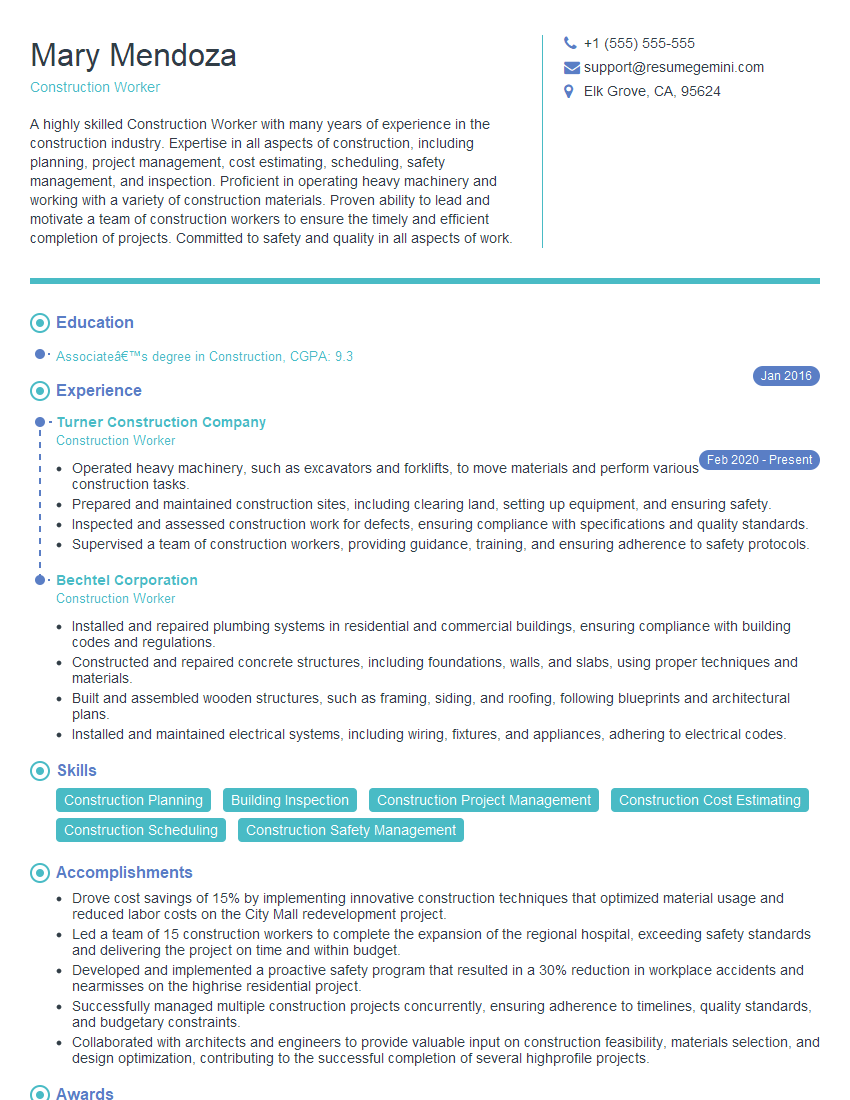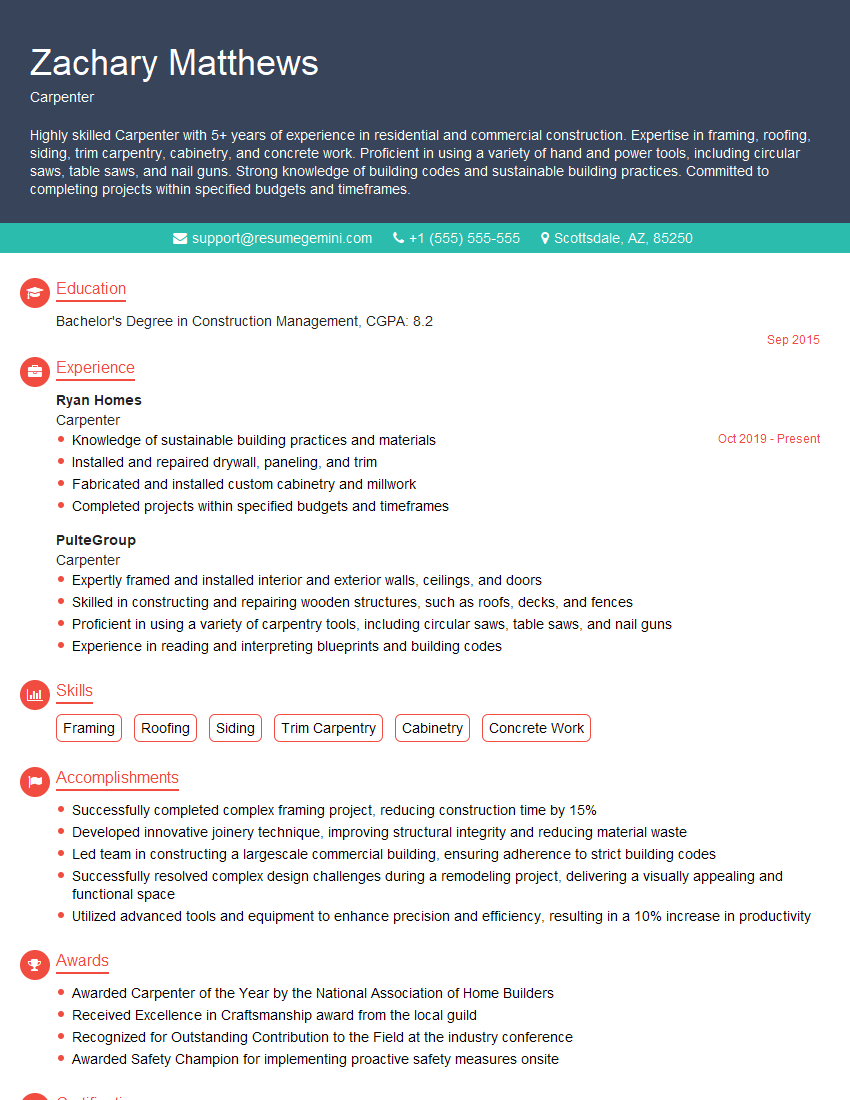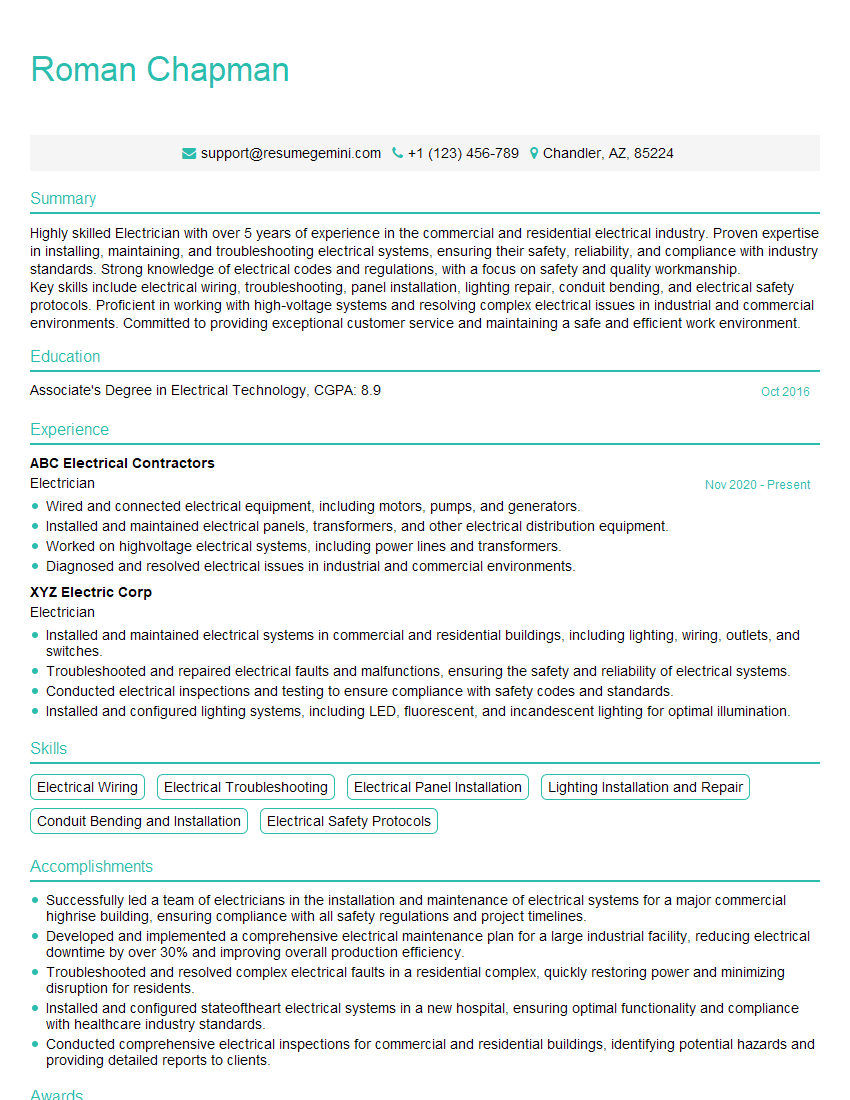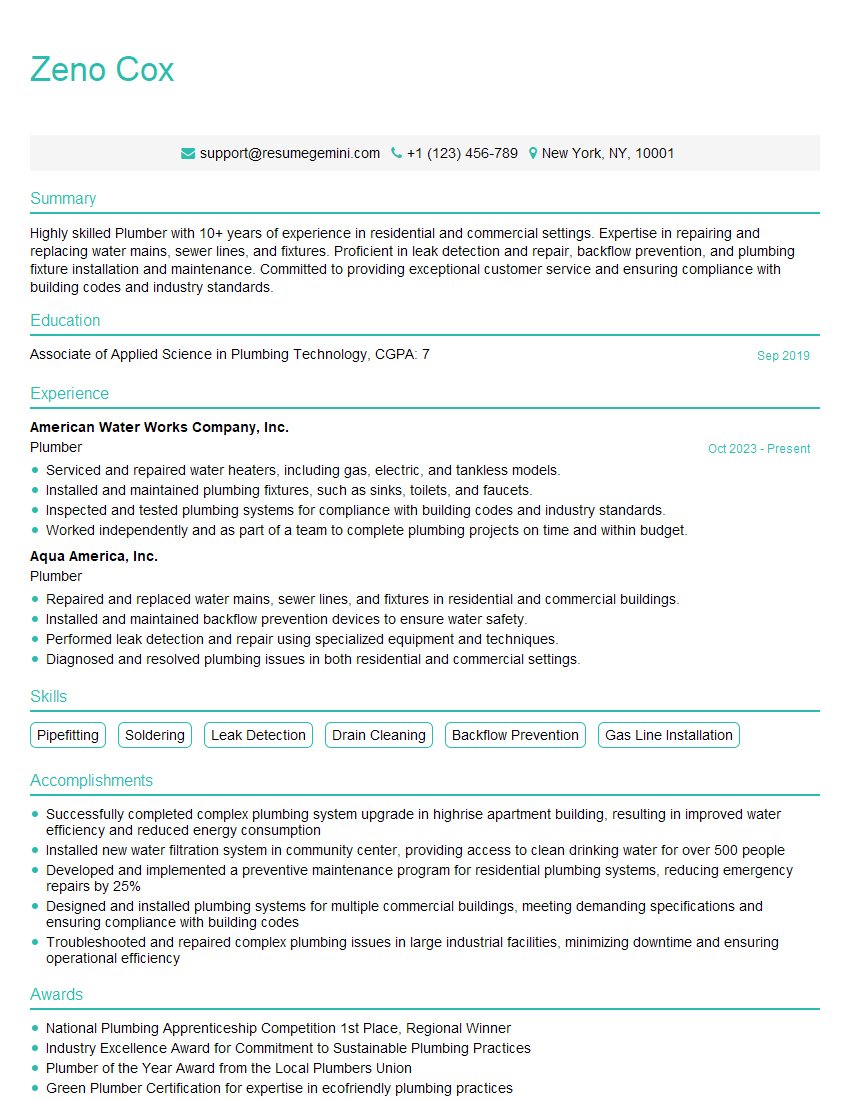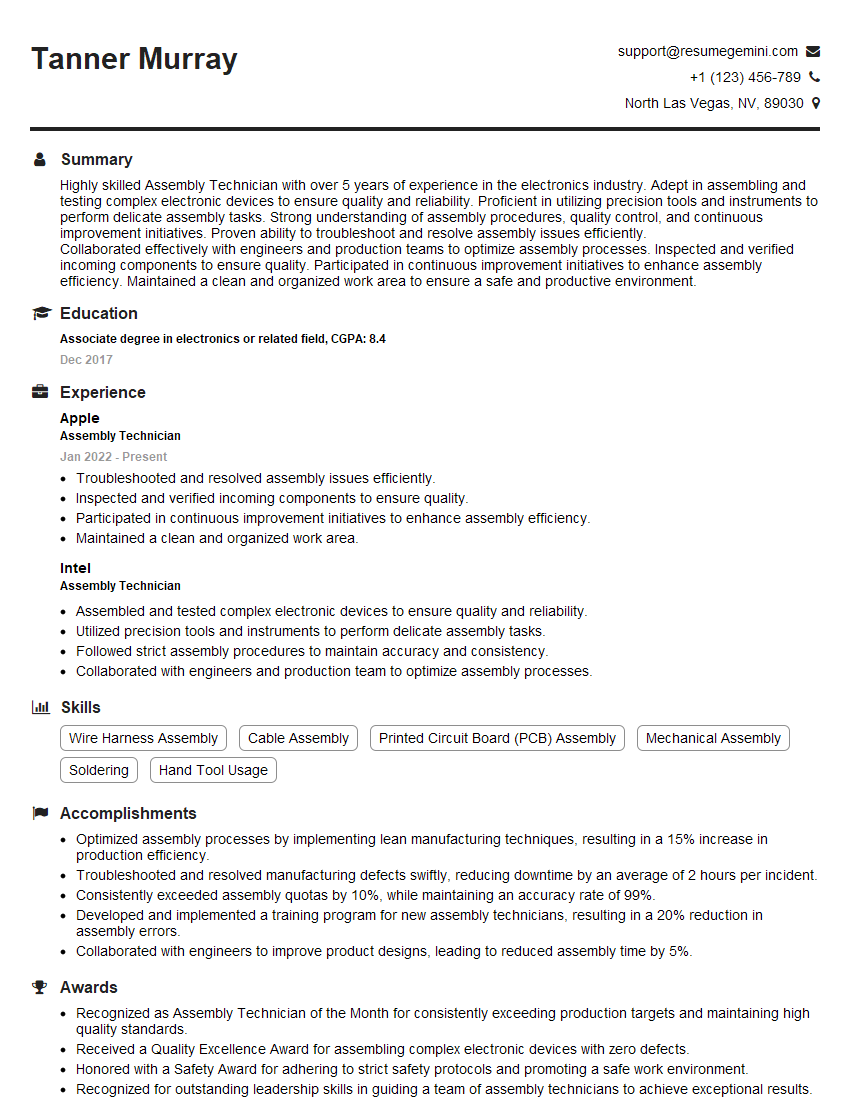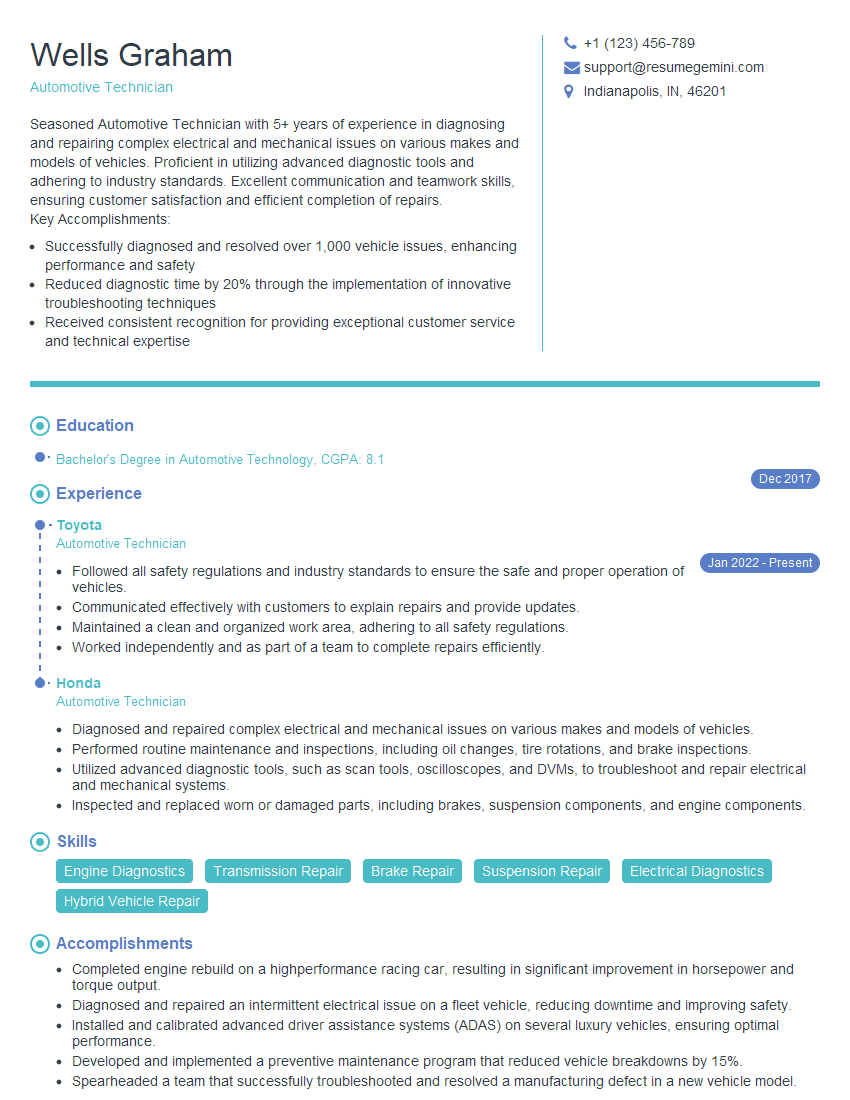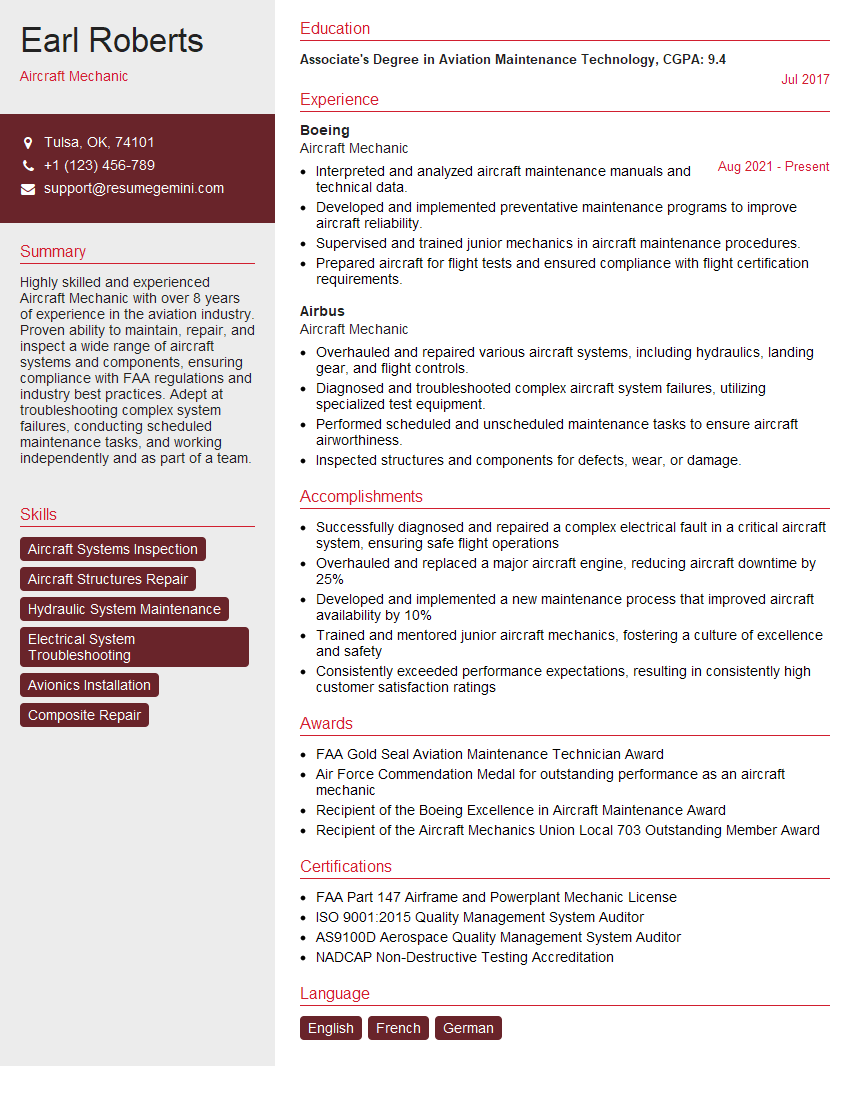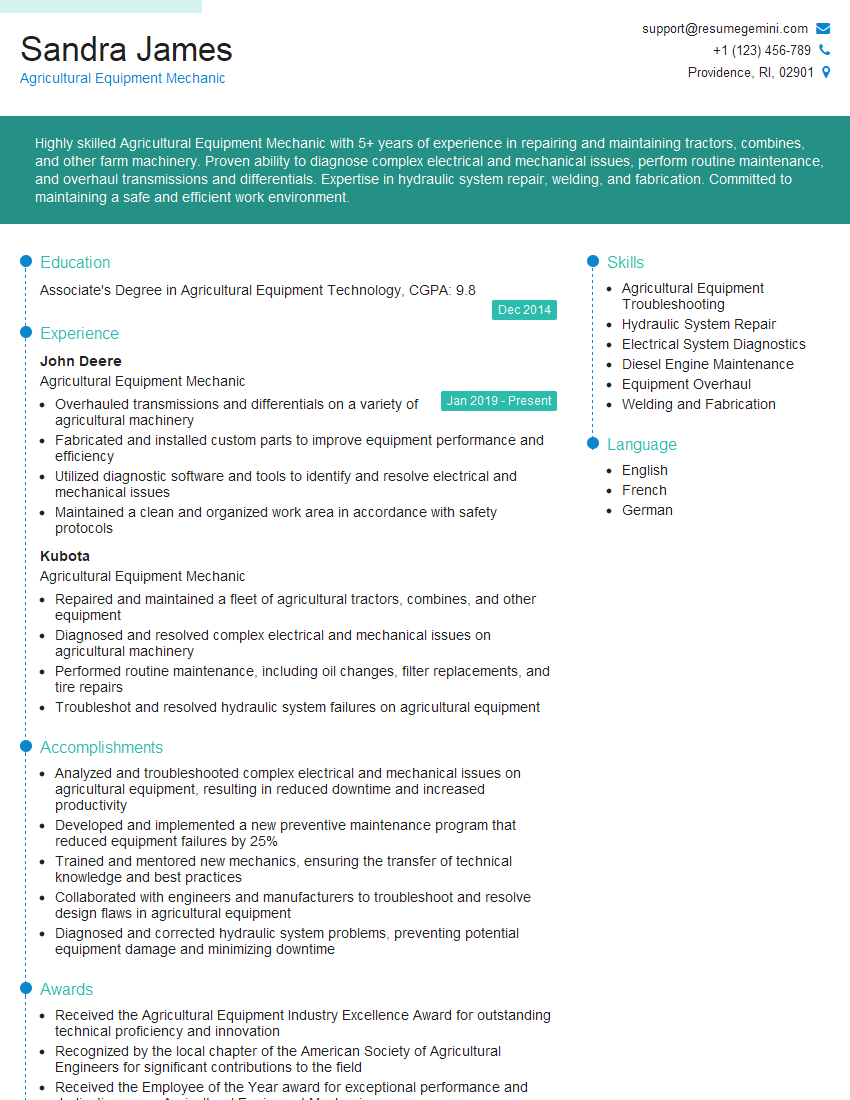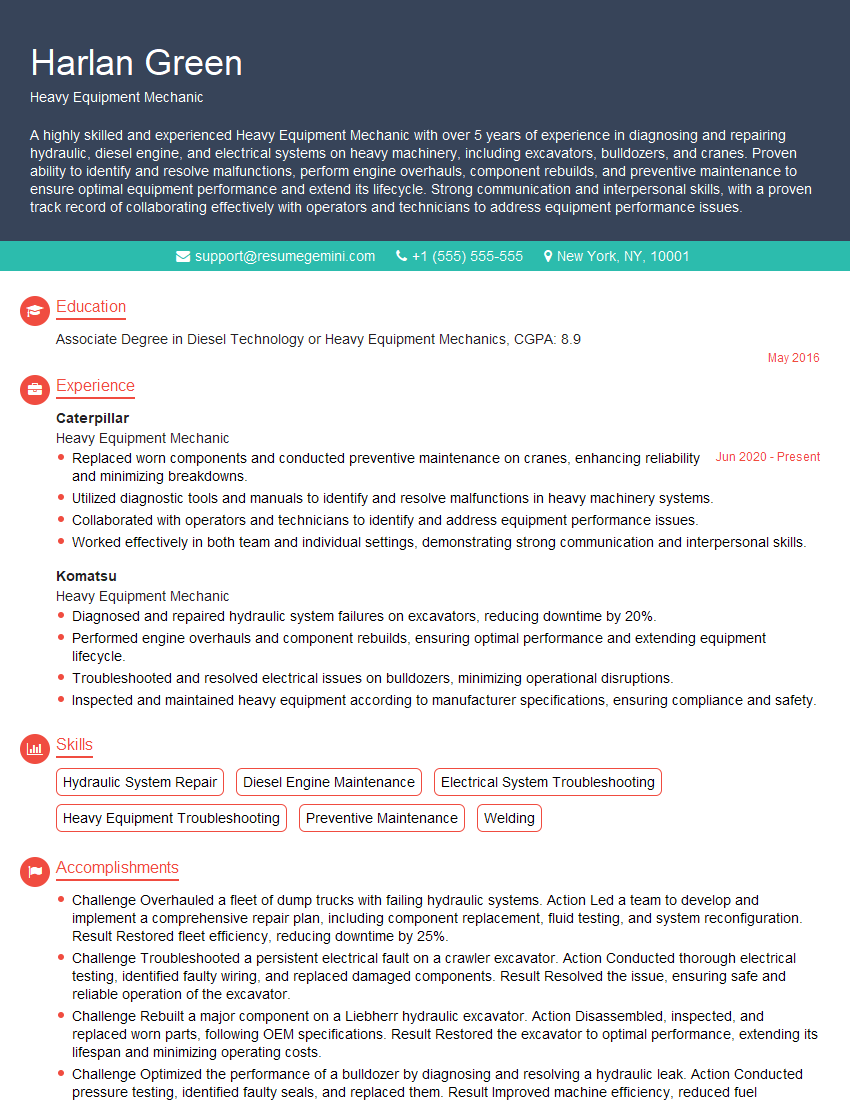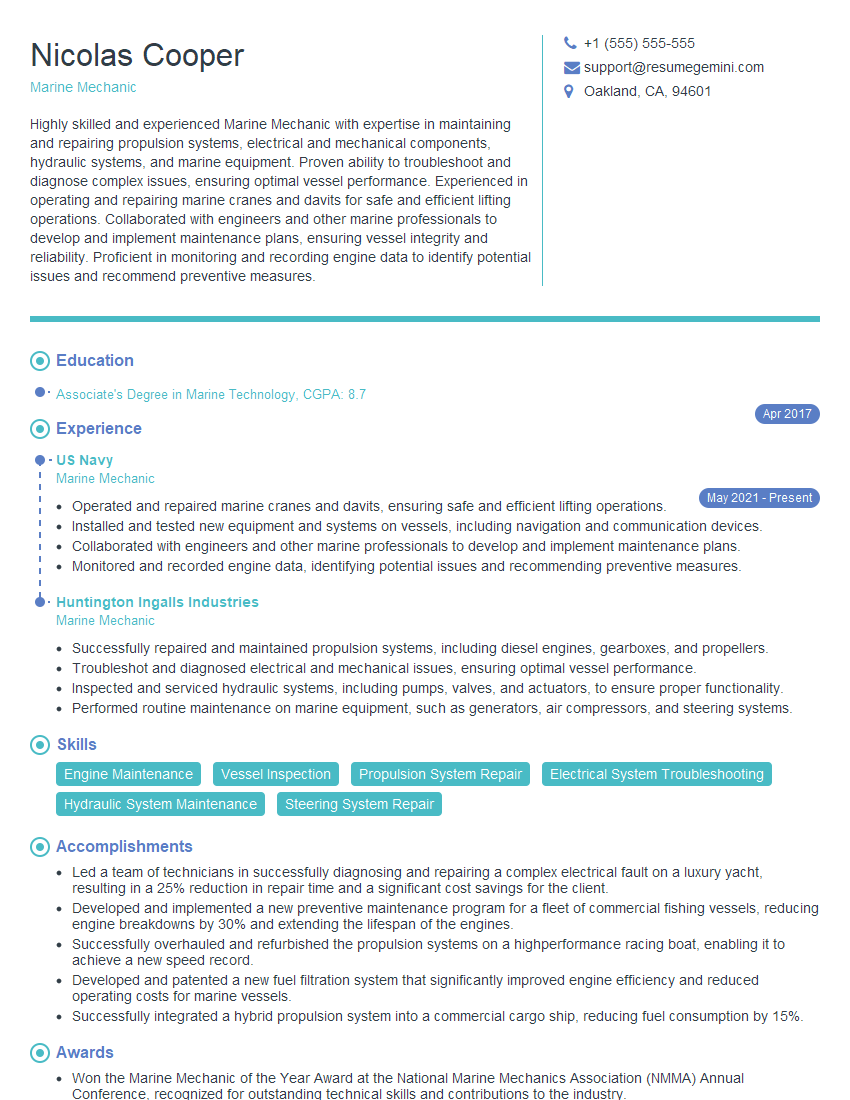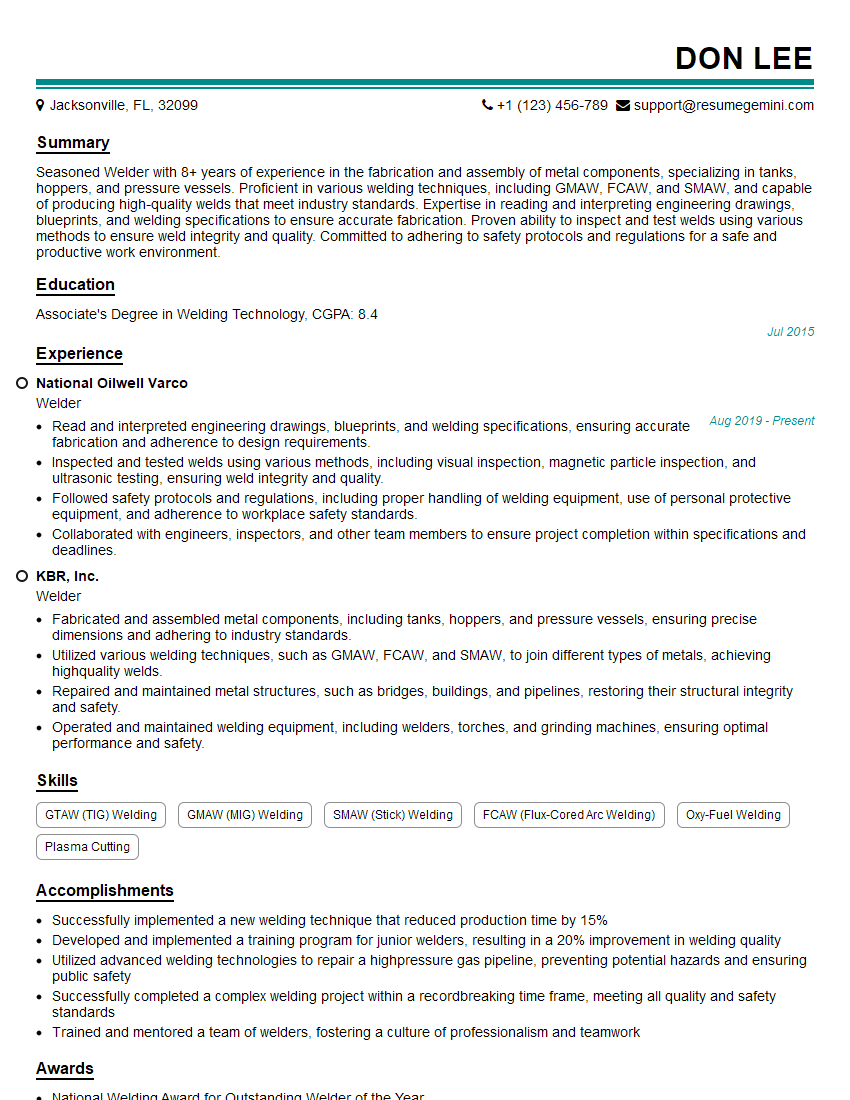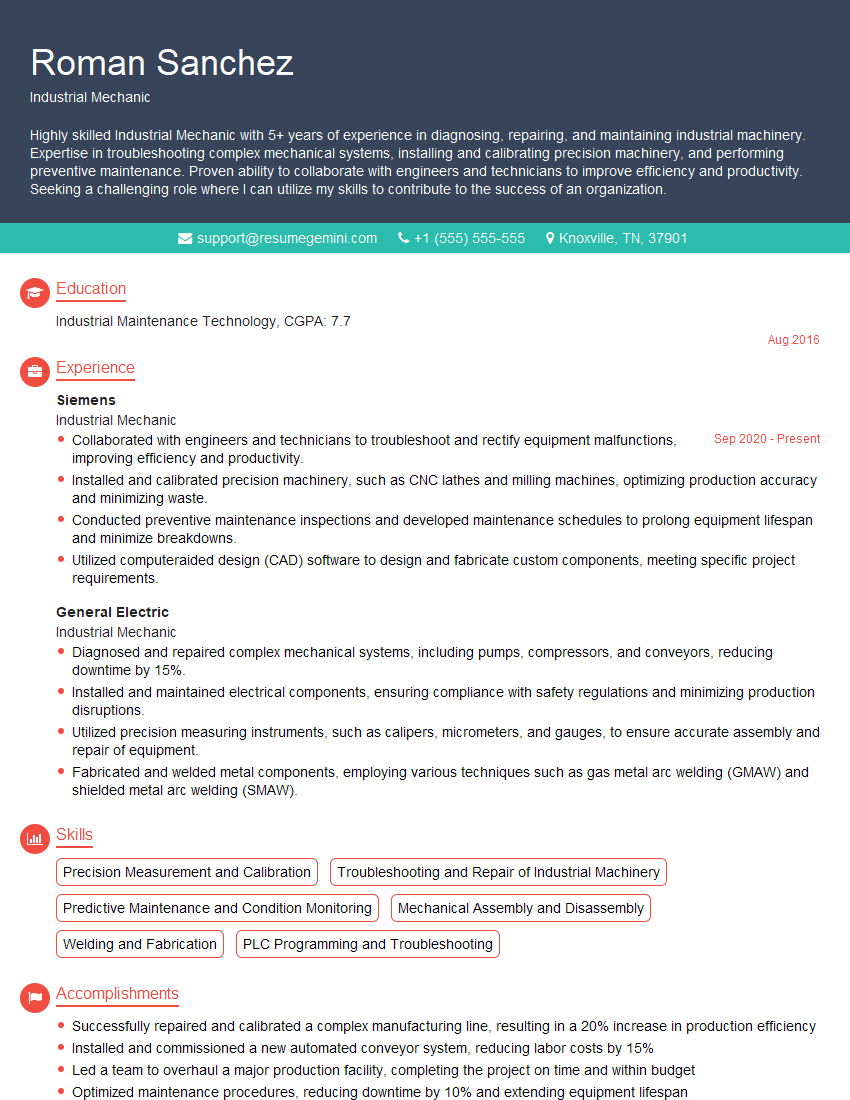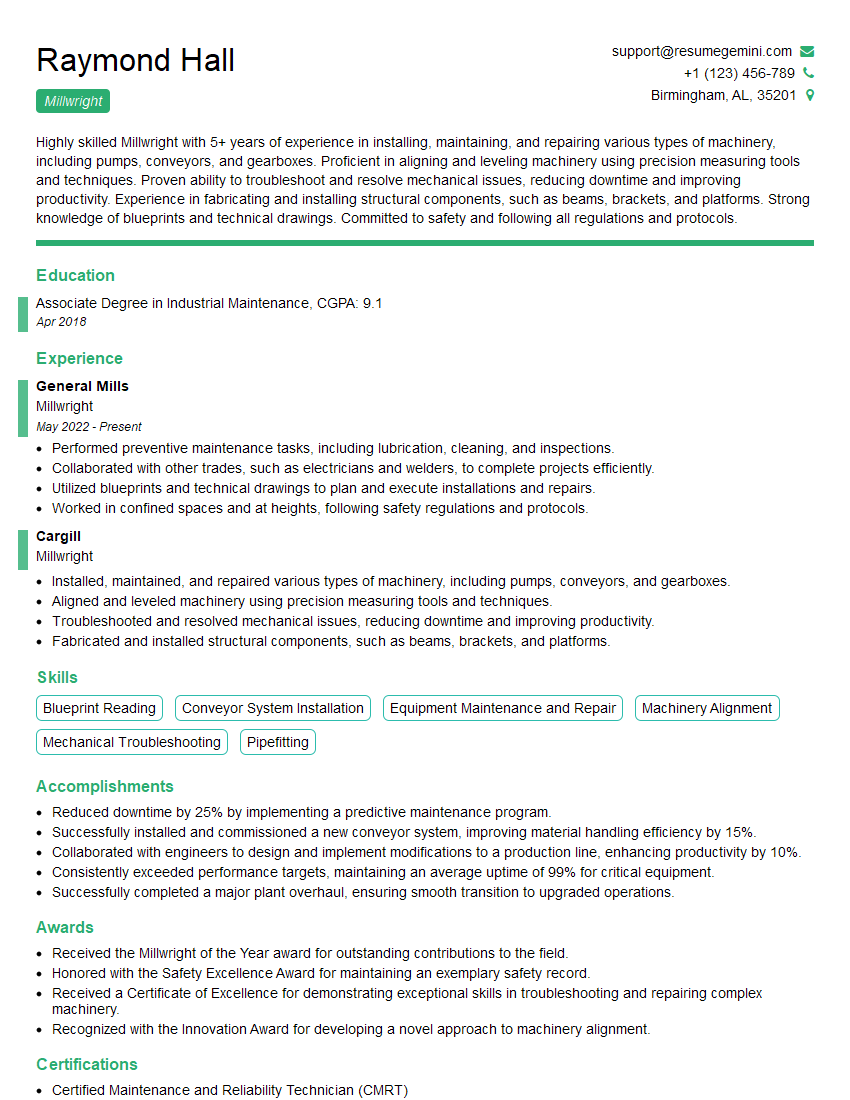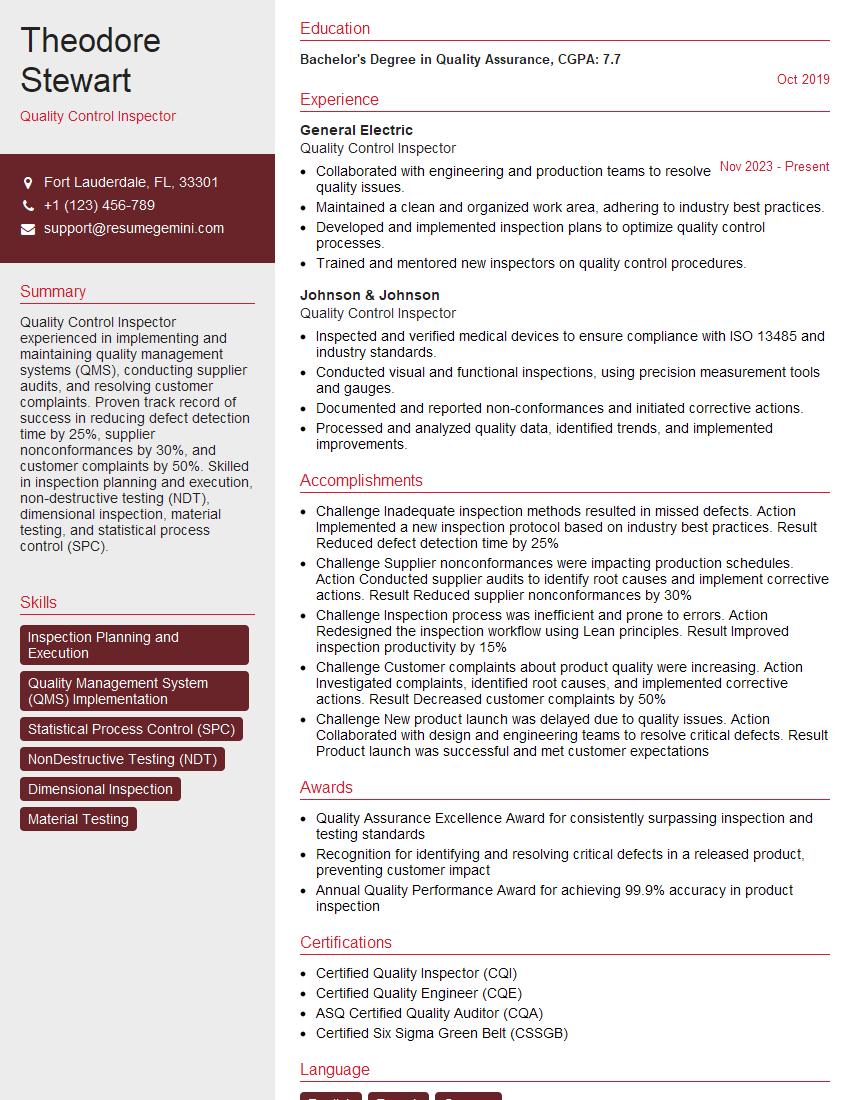Unlock your full potential by mastering the most common Ability to use tools and equipment effectively interview questions. This blog offers a deep dive into the critical topics, ensuring you’re not only prepared to answer but to excel. With these insights, you’ll approach your interview with clarity and confidence.
Questions Asked in Ability to use tools and equipment effectively Interview
Q 1. Describe your experience with hand tools (e.g., screwdrivers, wrenches).
My experience with hand tools spans over 15 years, encompassing various projects from intricate woodworking to complex mechanical repairs. I’m proficient in using a wide array of tools, including screwdrivers (Phillips, flathead, specialized bits), wrenches (adjustable, open-ended, socket), pliers (needle-nose, slip-joint, lineman’s), hammers, chisels, and saws (hand saws, coping saws, hacksaws). I understand the nuances of each tool – selecting the right tool for the job is crucial. For instance, I wouldn’t use a flathead screwdriver on a Phillips head screw; that could damage both the screw and the screwdriver. Similarly, I choose between an adjustable wrench and a socket wrench based on the access and torque required. I’m confident in my ability to select the correct tool and apply the appropriate technique for optimal efficiency and safety.
For example, during a recent furniture restoration project, I meticulously used a variety of chisels to carefully remove damaged sections of wood, ensuring I maintained the integrity of the underlying structure. The precision required for this task highlighted my understanding of the different chisel types and their applications.
Q 2. What safety precautions do you take when using power tools?
Safety is paramount when using power tools. My approach is multifaceted and starts before I even switch the tool on. It involves:
- Proper Personal Protective Equipment (PPE): This includes safety glasses or a face shield, hearing protection, work gloves appropriate for the task, and closed-toe shoes. I always assess the specific risks involved and adjust my PPE accordingly.
- Tool Inspection: Before each use, I thoroughly inspect power tools for damage, loose parts, or frayed cords. A damaged tool is a dangerous tool and should be immediately removed from service.
- Secure Work Area: I ensure my workspace is well-lit, clutter-free, and provides sufficient space to work safely. This prevents accidental trips and falls, and also keeps the work area clear of obstructions that could interfere with the tool’s operation.
- Correct Tool Operation: I always follow the manufacturer’s instructions for each tool and never attempt operations I’m not trained in. This includes understanding the specific safety features of each tool, such as safety switches and guards.
- Maintaining Awareness: I am always aware of my surroundings and potential hazards. I avoid distractions and never rush the job. I never operate power tools when I’m fatigued or under the influence of drugs or alcohol.
For example, when using a circular saw, I always use a push stick to keep my hands clear of the blade, and I ensure the blade guard is functioning correctly. This prevents accidental contact with the rotating blade, a significant safety hazard.
Q 3. How do you maintain and care for tools and equipment?
Maintaining tools and equipment is essential for their longevity and safe operation. My routine involves:
- Cleaning: After each use, I thoroughly clean tools to remove debris, dust, and grease. This prevents corrosion and ensures smooth operation.
- Lubrication: Moving parts of tools, such as hinges and joints, require regular lubrication to prevent wear and tear. I use appropriate lubricants based on the tool material.
- Sharpening: Cutting tools, like chisels and saw blades, require regular sharpening to maintain their effectiveness and safety. Dull tools are more prone to slips and accidents.
- Storage: I store tools in a dry, organized location to protect them from damage and rust. I use tool organizers and cases to prevent tools from clashing and getting damaged.
- Inspection: Regular visual inspections help identify potential issues early on, allowing for timely repairs and preventing more serious damage.
Imagine neglecting a saw blade; it becomes dull and inefficient, making cuts rough and potentially leading to injury. Regular sharpening keeps it performing optimally and safely.
Q 4. Explain your experience with specific equipment (e.g., CNC machines, welding equipment).
My experience with specialized equipment includes extensive work with CNC milling machines and TIG welding equipment. With CNC milling, I’m proficient in programming and operating various models, creating precise parts from various materials including aluminum, steel, and plastics. I understand G-code programming and can troubleshoot common machine errors. My experience with TIG welding includes welding various metals, such as stainless steel and aluminum, and I’m skilled in different welding techniques to achieve high-quality welds with excellent penetration and minimal distortion.
For instance, on a recent project, I used a CNC mill to machine a complex aluminum part with tight tolerances. The precision and repeatability of the CNC machine were critical for meeting the project’s requirements. My understanding of the machine’s capabilities and limitations allowed me to optimize the machining process for both speed and accuracy.
Q 5. Describe a time you had to troubleshoot a malfunctioning piece of equipment.
During a large-scale project involving a CNC lathe, the machine unexpectedly began producing inconsistent cuts. After a visual inspection revealed no immediate problems, I systematically troubleshooted the issue. I checked the following:
- Tooling: I inspected the cutting tool for wear or damage, replacing it with a sharp one.
- Workpiece: I examined the workpiece to ensure it was properly secured and aligned.
- Machine Settings: I reviewed the CNC program for errors and checked the machine’s settings, focusing on feed rates and spindle speed.
- Lubrication: I checked the lubrication system to ensure proper function.
Through this process of elimination, I identified the problem as a slight misalignment in the tailstock. After adjusting it, the machine produced consistent and accurate cuts. This experience highlighted the importance of methodical troubleshooting and a deep understanding of the equipment.
Q 6. How do you ensure the accuracy and precision of your work when using tools and equipment?
Accuracy and precision are critical. I achieve this through a combination of techniques:
- Calibration: I regularly calibrate tools and equipment according to manufacturer’s specifications. This ensures consistent and reliable measurements.
- Proper Measurement Techniques: I use appropriate measuring tools – calipers, micrometers, rulers – depending on the level of precision needed. I understand the limitations of each tool and choose the most appropriate one for the task.
- Precise Tool Handling: I handle tools carefully, avoiding undue force that could cause damage or inaccurate results.
- Multiple Measurements: I always take multiple measurements and compare them to ensure consistency and accuracy.
- Visual Inspection: I thoroughly inspect the final product for any imperfections or deviations from the specifications.
For instance, while working with precision instruments, I’d use a micrometer to ensure dimensions are within tolerances, rather than relying on a less precise ruler. The attention to detail guarantees the quality of my work.
Q 7. What is your experience with preventative maintenance of equipment?
Preventative maintenance is crucial for maximizing equipment lifespan and minimizing downtime. My approach to preventative maintenance includes:
- Scheduled Maintenance: I adhere to a schedule for routine maintenance tasks such as cleaning, lubrication, and inspections, often based on the manufacturer’s recommendations.
- Regular Inspections: I perform frequent visual inspections of equipment to identify potential issues before they escalate into major problems.
- Documentation: I maintain detailed records of all maintenance activities, including dates, tasks performed, and any issues discovered. This helps track the equipment’s history and allows for effective planning of future maintenance.
- Early Problem Detection: I am trained to recognize early signs of wear and tear, allowing for timely intervention and preventing catastrophic failures.
This proactive approach is similar to regular car maintenance; by addressing small issues promptly, you prevent larger, more costly repairs down the line. It’s a far more efficient and cost-effective strategy.
Q 8. Have you ever worked with specialized software to control equipment?
Yes, I have extensive experience with specialized software for equipment control. For instance, in my previous role at Acme Manufacturing, I used a CNC (Computer Numerical Control) machine programming software called Mastercam to control a milling machine. This software allowed me to create complex 3D models and translate them into precise instructions for the machine, controlling factors like cutting speed, depth, and feed rate. Another example involves using a Programmable Logic Controller (PLC) programming software like RSLogix 5000 to automate and monitor a production line. This involved writing code to control the sequence of operations, monitor sensor inputs, and manage outputs to ensure efficient and consistent product manufacturing. These experiences provided me with a solid understanding of the interplay between software and hardware, emphasizing the importance of precision and safety in automated systems.
Q 9. How do you adapt to using new or unfamiliar tools and equipment?
Adapting to new tools and equipment is a crucial skill for me. My approach is systematic and involves several steps. First, I thoroughly read the manufacturer’s manual, paying close attention to safety precautions and operational procedures. Then, I conduct a hands-on trial run, starting with simple tasks and gradually increasing complexity. This allows me to familiarize myself with the controls, functionalities, and any unique characteristics of the equipment. If available, I also look for online tutorials or training videos to supplement my understanding. I find that visualizing the process through diagrams or flowcharts helps solidify my grasp of the equipment’s operation. For example, when I first encountered a new type of welding machine, I started by practicing on scrap metal, gradually increasing the complexity of the weld until I felt comfortable with the machine’s capabilities. This systematic approach minimizes the risk of errors and ensures efficient learning.
Q 10. Describe your experience with calibration procedures for measuring tools.
Calibration procedures are critical for ensuring accurate measurements. My experience involves using various measuring tools, from micrometers and calipers to laser levels and pressure gauges. I understand the importance of following manufacturer-specified calibration procedures, which often involve using certified standards and recording the results. For example, when calibrating a digital caliper, I would use a gauge block of known accuracy to check the zero point and several other points across the caliper’s range. Any deviations are recorded, and adjustments are made according to the manufacturer’s instructions. This process ensures the accuracy of measurements, which is crucial for quality control and consistent product output. Neglecting calibration can lead to significant errors and potential product defects.
Q 11. What are your preferred methods for diagnosing equipment problems?
My approach to diagnosing equipment problems is methodical and involves several steps. First, I carefully observe the equipment for any visible signs of damage or malfunction. Then, I check all the connections, ensuring they are secure and properly functioning. Next, I consult the equipment’s manual or troubleshooting guides to identify potential causes of the problem. I also check relevant sensor readings and error codes if the equipment has digital displays. If the problem persists, I may utilize specialized diagnostic tools such as multimeters or oscilloscopes to pinpoint the fault. For example, if a motor fails to start, I would first check the power supply, then the motor windings for continuity using a multimeter, and finally, check the control circuitry. This systematic process helps me efficiently identify and resolve equipment problems.
Q 12. Explain your understanding of safety regulations concerning specific tools and equipment.
Safety regulations are paramount when working with tools and equipment. My understanding encompasses several key areas, including the proper use of Personal Protective Equipment (PPE) such as safety glasses, gloves, and hearing protection. I am also familiar with lockout/tagout procedures for isolating equipment during maintenance or repair to prevent accidental startup. Furthermore, I understand and adhere to specific safety regulations related to different types of equipment, like the safe handling and storage of compressed gases, the proper use of lifting equipment to avoid injuries, and understanding the hazards associated with specific chemicals and materials. I regularly update my knowledge on relevant safety standards and best practices to ensure I maintain a safe working environment. Prioritizing safety is not just a rule, but a fundamental aspect of my work ethic.
Q 13. How do you handle unexpected equipment failures during a critical task?
Handling unexpected equipment failures during a critical task requires a calm and systematic approach. My first priority is always safety. I immediately shut down the equipment if necessary and ensure the safety of myself and others around. Then, I assess the situation to determine the nature and extent of the failure. I communicate the issue to my supervisor or team leader immediately. Depending on the nature of the failure and the urgency of the task, I may attempt temporary repairs or workarounds, always ensuring these are safe and do not compromise the quality of the work. If a repair cannot be made quickly, I will explore alternative methods or equipment to complete the task, documenting the issue thoroughly for later analysis and preventive measures.
Q 14. Describe your experience with different types of welding equipment.
I have experience with several types of welding equipment, including Gas Metal Arc Welding (GMAW), also known as MIG welding, Gas Tungsten Arc Welding (GTAW), or TIG welding, and Shielded Metal Arc Welding (SMAW), or stick welding. GMAW is commonly used for its speed and ease of use, particularly in production environments. GTAW is preferred for its high-quality welds and precision, ideal for critical applications. SMAW is versatile and portable, suitable for various outdoor applications. My experience extends to understanding the differences in welding parameters, such as voltage, amperage, and shielding gas, depending on the material being welded and the desired outcome. I’m familiar with the setup, operation, and maintenance of these different welding machines, including troubleshooting common issues such as arc instability or poor weld quality. Safety procedures specific to each welding process are equally important, and I always prioritize safe working practices.
Q 15. What is your experience using measuring instruments (e.g., calipers, micrometers)?
My experience with measuring instruments like calipers and micrometers is extensive. I’ve used them extensively throughout my career, from precision machining to quality control inspections. I’m proficient in using both vernier calipers (capable of measuring to 0.01 mm or 0.0005 inches) and digital calipers (offering even greater precision and ease of reading). With micrometers, I’m comfortable using both outside and inside micrometers, accurately measuring extremely small dimensions with a resolution often down to 0.001 mm or 0.00005 inches. For example, during my work at Acme Manufacturing, I regularly used micrometers to measure the diameter of precisely manufactured shafts, ensuring they met stringent tolerance requirements. My understanding extends beyond simply reading the instruments; I’m also adept at understanding and accounting for zero errors, parallax errors, and wear and tear, which ensures accuracy.
Career Expert Tips:
- Ace those interviews! Prepare effectively by reviewing the Top 50 Most Common Interview Questions on ResumeGemini.
- Navigate your job search with confidence! Explore a wide range of Career Tips on ResumeGemini. Learn about common challenges and recommendations to overcome them.
- Craft the perfect resume! Master the Art of Resume Writing with ResumeGemini’s guide. Showcase your unique qualifications and achievements effectively.
- Don’t miss out on holiday savings! Build your dream resume with ResumeGemini’s ATS optimized templates.
Q 16. How do you ensure that the equipment you use is in compliance with safety standards?
Ensuring equipment compliance with safety standards is paramount. My approach is multifaceted. First, I always begin by visually inspecting the equipment before use – checking for any signs of damage, loose parts, or frayed wiring. Second, I thoroughly review and understand the manufacturer’s instructions and safety guidelines. This includes familiarizing myself with any specific personal protective equipment (PPE) required, such as safety glasses, gloves, or hearing protection. Third, I ensure that all safety features are functional – emergency stops, guards, and interlocks are all crucial and must be regularly checked. Fourth, I adhere to all company safety protocols and participate actively in regular safety training sessions to stay updated on best practices and any changes in regulations. For instance, during a recent project involving high-pressure hydraulics, I meticulously inspected the system’s pressure relief valve and ensured it was properly calibrated before commencing operations. This proactive approach prevents accidents and ensures a safe working environment.
Q 17. What is your understanding of the different types of industrial lubricants and their applications?
My understanding of industrial lubricants is comprehensive. I’m familiar with various types, including:
- Mineral oils: These are widely used due to their cost-effectiveness and decent performance in many applications. However, their performance can degrade at extreme temperatures.
- Synthetic oils: These offer superior performance at extreme temperatures and pressures, along with enhanced oxidation resistance and longer lifespan compared to mineral oils. They are usually more expensive.
- Grease: Used for lubricating moving parts in situations where oil might leak or be difficult to retain. Different greases are formulated for different applications, such as high-temperature or high-pressure environments.
- Specialty lubricants: This broad category encompasses lubricants with specific additives for improved performance in unique situations; for example, extreme-pressure (EP) lubricants for heavily loaded gears, or food-grade lubricants for the food processing industry.
Selecting the right lubricant depends on factors such as the operating temperature, the type of equipment, the load, and the environment. Incorrect lubricant selection can lead to premature equipment failure, increased wear, and reduced efficiency. I’ve found it helpful to consult lubrication charts and manufacturer’s recommendations to ensure proper selection.
Q 18. Explain your process for selecting the appropriate tools for a given task.
Selecting the appropriate tools is a crucial step that I approach methodically. My process typically involves:
- Understanding the task: Clearly defining the task at hand – what needs to be done and what is the desired outcome – is critical.
- Material consideration: The material being worked with dictates the type of tool needed. For example, soft wood requires different tools than hardened steel.
- Tool capabilities: I consider the capabilities of various tools and select the one that best matches the job’s requirements. For instance, a drill press is preferable to a hand drill for accuracy and efficiency in drilling many holes.
- Safety considerations: I always prioritize safety. Selecting the right tool also means choosing the appropriate safety equipment like eye protection or gloves.
- Availability: Finally, I choose from the tools available, ensuring they are in good working order and properly maintained.
For example, during a recent project requiring the precise removal of a nut and bolt in a confined space, I chose a ratcheting wrench with a swivel head for enhanced maneuverability and precision over a standard wrench, ensuring both efficiency and safety.
Q 19. Describe your experience working with pneumatic or hydraulic systems.
I have significant experience working with both pneumatic and hydraulic systems. With pneumatic systems (using compressed air), I’m familiar with various components like air compressors, air cylinders, valves, and pneumatic tubing. I understand the principles of air pressure regulation, flow control, and the importance of proper air filtration to prevent contamination and system damage. With hydraulic systems (using pressurized oil), I’ve worked with hydraulic pumps, hydraulic cylinders, valves, and hydraulic fluids. This includes understanding hydraulic pressure, flow rate, and the critical need for cleanliness to prevent contamination. In one project, I successfully troubleshot a malfunctioning hydraulic press by identifying a leak in a hydraulic line and replacing the faulty component, leading to a prompt resumption of operations. Understanding the safety precautions associated with high-pressure systems, like pressure relief valves and emergency shutoff mechanisms, is paramount and something I prioritize.
Q 20. How do you prioritize tasks when working with multiple tools and equipment?
Prioritizing tasks when working with multiple tools and equipment involves a systematic approach. I typically use a combination of urgency, dependency, and impact assessment.
- Urgency: Tasks with immediate deadlines or those that could cause immediate safety hazards are prioritized.
- Dependency: Tasks that are dependent on the completion of others are sequenced accordingly. For example, assembly tasks often follow a specific sequence.
- Impact: Tasks with the greatest impact on the overall project are given precedence.
I often use visual aids like task lists or flowcharts to map out the sequence and keep track of progress. This structured approach ensures efficient workflow and helps to avoid bottlenecks.
Q 21. What is your experience with programmable logic controllers (PLCs)?
My experience with Programmable Logic Controllers (PLCs) includes both basic programming and troubleshooting. I’m proficient in ladder logic programming, using software such as RSLogix 5000, and I understand how to read and interpret PLC programs. I’ve worked on projects involving PLC integration with various industrial equipment, such as conveyor systems, robotic arms, and automated machinery. My troubleshooting skills encompass identifying and resolving issues using diagnostic tools like online monitoring and analyzing alarm logs. For example, during a recent incident, I used a PLC’s diagnostic capabilities to identify a faulty sensor causing a production line to stop. I was then able to quickly replace the sensor and get the line back up and running, minimizing downtime.
Q 22. Describe a time you had to repair or replace a broken part on a piece of equipment.
During my time as a maintenance technician at a manufacturing plant, a critical component on our CNC milling machine – the spindle motor – failed. The machine was essential for production, so downtime was extremely costly.
My first step was a thorough diagnosis. I checked the power supply, examined the motor for visible damage (burnt wiring, loose connections), and consulted the machine’s troubleshooting manual. The manual pointed towards a failed bearing within the spindle motor. Replacing the entire motor was far more expensive than just replacing the bearing. So, I carefully disassembled the spindle, identifying the faulty bearing using its unique part number found etched onto the component. I ordered the replacement bearing, ensuring it matched the exact specifications. Once the new bearing arrived, I carefully reassembled the spindle, following the manufacturer’s instructions precisely. After reassembly, I conducted rigorous tests to ensure proper functionality and alignment. This approach saved the company significant costs and minimized downtime.
Q 23. How familiar are you with different types of industrial control systems?
I’m highly familiar with various industrial control systems, including Programmable Logic Controllers (PLCs), Supervisory Control and Data Acquisition (SCADA) systems, and Distributed Control Systems (DCS). I have practical experience with Allen-Bradley PLCs (specifically, the CompactLogix and ControlLogix platforms), Siemens SIMATIC PLCs, and basic SCADA systems using software like Ignition.
My understanding extends beyond just programming; I’m comfortable with troubleshooting these systems, reading ladder logic diagrams, understanding process control loops, and interpreting sensor data. For example, I once diagnosed a malfunction in a PLC controlling a conveyor belt system by analyzing the ladder logic and identifying a faulty input from a proximity sensor. Replacing the sensor solved the problem immediately. I’m also proficient in understanding and configuring human-machine interfaces (HMIs) for improved operator interaction.
Q 24. Describe your experience with different types of cutting tools.
My experience encompasses a wide range of cutting tools, from hand tools to power tools. With hand tools, I’m proficient in using chisels, files, hacksaws, and various types of screwdrivers for precise work. Regarding power tools, I have extensive experience with:
- Milling Machines: Operating various types of end mills for shaping metal and plastic parts.
- Lathes: Turning cylindrical components using different cutting inserts and tooling.
- Drill Presses: Drilling holes of varying sizes and depths in various materials.
- Grinders: Using angle grinders and bench grinders for shaping and finishing components.
- Saws: Using circular saws, band saws, and jigsaws for cutting different materials.
I understand the importance of selecting the right tool for the job, considering factors like material hardness, desired finish, and safety. For example, I would never use a high-speed steel drill bit on hardened steel without the proper coolant. Improper tool selection can lead to broken tools, damaged workpieces, and even injury.
Q 25. How do you interpret technical manuals and schematics for equipment?
Interpreting technical manuals and schematics is crucial for my work. My approach involves a systematic process:
- Initial Overview: I first skim the entire manual to get a general understanding of the equipment and its functionality.
- Specific Section Focus: I then focus on the sections relevant to the problem at hand. This might involve referring to wiring diagrams, exploded views of components, or troubleshooting flowcharts.
- Detailed Examination: I carefully examine diagrams, paying attention to details such as component numbers, wiring connections, and safety precautions.
- Cross-referencing: I often cross-reference information across different sections of the manual or consult supplementary documentation to ensure accuracy.
- Practical Application: Finally, I apply my understanding of the documentation to the equipment itself, validating my interpretations with practical observations.
Imagine trying to understand the hydraulic system of a large press. The schematics show the sequence of valves, pumps, and cylinders. By carefully tracing the flow of hydraulic fluid through these components, I can diagnose a leak or understand how pressure is regulated.
Q 26. What is your experience with robotic equipment or automation systems?
My experience with robotic equipment and automation systems is growing, though I haven’t had extensive hands-on experience with complex robot programming. I’ve worked alongside robotic systems on the factory floor, such as robotic welding cells and automated guided vehicles (AGVs). My role involved understanding their operational limits, safety protocols, and how they integrate into the larger manufacturing process.
For example, I assisted in troubleshooting a robotic arm’s malfunction. This involved examining the robot’s error messages, consulting the robot’s teach pendant and programming software, and reviewing the operational data. The issue turned out to be a calibration problem with the robot’s end effector. I was not responsible for directly reprogramming the robot, but my understanding of the system allowed me to identify the problem and accurately communicate it to the robotics technician. I am eager to expand my skill set in this area.
Q 27. Describe a situation where you improved the efficiency of a process by using tools or equipment more effectively.
In a previous role, we were experiencing bottlenecks in our assembly line due to inefficient use of pneumatic tools. Operators were struggling with the existing fastening tools, leading to slower assembly times and increased fatigue.
I analyzed the process and identified that the air pressure settings on the pneumatic tools were suboptimal. I worked with operators to find a suitable air pressure that provided adequate fastening torque without excessive force or vibration. Furthermore, I introduced a simple jig to hold the components in place, enabling faster and more consistent tool application. These two improvements resulted in a 15% increase in assembly speed and reduced operator fatigue. This improvement demonstrated the impact of both tool optimization and process redesign on overall efficiency.
Q 28. What steps do you take to ensure the safe and proper storage of tools and equipment?
Safe and proper storage of tools and equipment is paramount for safety and efficiency. My approach involves:
- Designated Storage Areas: Tools are stored in designated, clearly labeled areas, organized by type and function to avoid confusion and delays.
- Proper Tool Handling: I make sure to clean and inspect tools after each use to identify any damage or wear and tear. Tools are stored in their appropriate containers or racks to prevent accidental damage or loss.
- Safety First: Sharp tools are stored in protective sheaths or cases. Power tools are stored securely, disconnected from power sources, and in a manner that prevents accidental activation.
- Inventory Management: Regular inventory checks ensure that tools are available and accounted for. This minimizes downtime due to missing or misplaced equipment.
- Environmental Protection: Tools sensitive to moisture, extreme temperatures, or corrosive environments are stored in appropriate protective conditions.
Think of it like a well-organized toolbox – everything has its place, readily accessible, and well-maintained. This approach promotes efficiency, prevents accidents, and extends the life of the tools.
Key Topics to Learn for Ability to use tools and equipment effectively Interview
- Safety Procedures and Regulations: Understanding and adhering to all relevant safety protocols when operating tools and equipment. This includes proper personal protective equipment (PPE) usage and emergency procedures.
- Equipment Operation and Maintenance: Demonstrating proficiency in the safe and efficient operation of various tools and equipment relevant to your field. This includes preventative maintenance and basic troubleshooting.
- Troubleshooting and Problem-Solving: Articulating your approach to identifying and resolving malfunctions or inefficiencies in tool and equipment operation. Providing examples of how you’ve diagnosed and fixed issues.
- Technical Knowledge and Specifications: Displaying a strong understanding of the technical specifications and capabilities of the tools and equipment you’ve used. Knowing the limitations and appropriate applications.
- Quality Control and Precision: Explaining your methods for ensuring the accuracy and precision of work performed using tools and equipment. Highlighting your attention to detail.
- Efficiency and Productivity: Demonstrating your ability to use tools and equipment effectively to maximize productivity and minimize waste. Offering examples of process improvements you’ve implemented.
- Calibration and Testing: Understanding the importance of calibration and testing for ensuring accuracy and reliability of equipment and tools. Describe your experience with calibration procedures.
Next Steps
Mastering the ability to use tools and equipment effectively is crucial for career advancement in many fields. It demonstrates practical skills, problem-solving abilities, and a commitment to safety and efficiency – all highly valued by employers. To significantly boost your job prospects, create an ATS-friendly resume that clearly highlights your expertise. ResumeGemini is a trusted resource to help you build a professional and impactful resume. We provide examples of resumes tailored to showcase proficiency in “Ability to use tools and equipment effectively,” helping you present your skills effectively to potential employers.
Explore more articles
Users Rating of Our Blogs
Share Your Experience
We value your feedback! Please rate our content and share your thoughts (optional).
What Readers Say About Our Blog
Hi, I have something for you and recorded a quick Loom video to show the kind of value I can bring to you.
Even if we don’t work together, I’m confident you’ll take away something valuable and learn a few new ideas.
Here’s the link: https://bit.ly/loom-video-daniel
Would love your thoughts after watching!
– Daniel
This was kind of a unique content I found around the specialized skills. Very helpful questions and good detailed answers.
Very Helpful blog, thank you Interviewgemini team.
